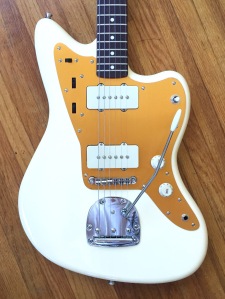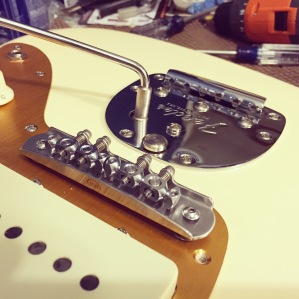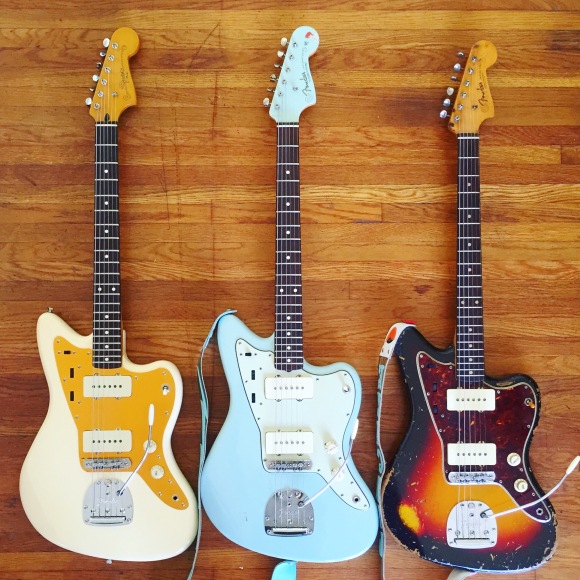 As you can imagine, I get asked about mods all the time. Recently, my new friend Brent brought his Squier J. Mascis model to me to hear my impressions of it and the many potential upgrades he was looking to have done. As-is, the JMJM is such a good guitar that many players don’t see the need for new pickups or hardware, but given the cheap price he paid and his needs, it totally made sense to do the work.
As you can imagine, I get asked about mods all the time. Recently, my new friend Brent brought his Squier J. Mascis model to me to hear my impressions of it and the many potential upgrades he was looking to have done. As-is, the JMJM is such a good guitar that many players don’t see the need for new pickups or hardware, but given the cheap price he paid and his needs, it totally made sense to do the work.
As I said before, the JMJM is a pretty cool guitar for the money. The neck feels great in your hand, the stock pickups are alright, and it has all of the right electronic appointments a Jazzmaster should have. Still, there’s room for improvement. Let’s jump in, shall we?
Tuners: Actually, these are good enough that I don’t see the need for a swap. As long as know how to string a slotted post correctly (string goes in the hole, 3-5 wraps) they work just fine. Great, actually. Even on my Squier VI!
Pickups: The stock units are pretty decent, but they are indeed P90s instead of Jazzmaster pickups, with big bar magnets and adjustable poles, with a tall coil that’s wound hot. If you want a real Jazzmaster sound, you’re not going to get it from those. Plus, as far as P90s go, I just feel there are better ones out there. I recommend a swap.
Electronics: On this particular instrument, I didn’t totally rewire the guitar. Generally, the one area where the current Squier builds fall short is the dependability of the electronics, which often develop shorts due to sloppy wiring or inferior parts. Instead, I went through and checked every wire and re-flowed some particularly bad connections. I do, however, recommend gutting the electronics and starting fresh with better components.
AOM/TOM Bridge: If you’re familiar with us, you’ll know that the AOM/TOM is the bridge we least recommend for offset guitars, both for sound and setup. Adjust-O-Matic/Tune-O-Matic bridges generally aren’t the correct radius for the most common Fender necks (7.25” and 9.5”) and even with heavy re-slotting of the saddles, it’s not always possible to totally correct that. As a result, the E strings will always feel more stiff than the others.
Additionally, even these bridges don’t always address the most common complaints with the original style bridges: buzzing and stability. This bridge already had some pretty nasty buzzing going on, which was mostly cured by re-seating the saddles. A shallow slot on the low E saddle meant that string impulsively jumped out with heavy picking as well. I recommend a change here, but obviously, your mileage will vary.
A Mastery bridge is almost always my first pick here, which does indeed require pulling the old AOM/TOM inserts, filling the holes, then re-drilling. Staytrem also makes a drop-in thimble replacement for these, so do keep that in mind if you’re looking for something less, well, surgical. They also used to make a drop-in replacement, but I can’t seem to find it on their site. I may be interneting improperly.
The Vibrato: I won’t totally rehash my arguments from our prior blog post on the quality issues of import vibrato units, but suffice it to say, if you’re a heavy trem user––hell, even a pedestrian––you should consider an upgrade here. Tuning stability is key, and the sloppy fit of the internals on these can be a nightmare.
In this case, we went with an American Vintage Reissue trem from eBay user trickedoutguitar, which came with the correct AVRI arm with the ever-so-lovely, gentle bend. Mastery also makes a delightful trem of their own, which I recommend highly for truly intense users.
 So, when we finished our assessment meeting, I made my list of recommendations known. With Duncan Antiquity Is, a Mastery M1 kit, and an AVRI trem, I felt we’d pretty much covered everything. Obviously, the Mastery and pickups can be a significant investment for such an affordable guitar, but Brent wanted a guitar that would meet his needs without having to think about it ever again. Good call, says I.
So, when we finished our assessment meeting, I made my list of recommendations known. With Duncan Antiquity Is, a Mastery M1 kit, and an AVRI trem, I felt we’d pretty much covered everything. Obviously, the Mastery and pickups can be a significant investment for such an affordable guitar, but Brent wanted a guitar that would meet his needs without having to think about it ever again. Good call, says I.
After doing all of that and a proper setup by Yours Truly, I really believe we made a good instrument great. The difference in tone, unplugged and amplified, was immediately apparent. Whereas the guitar sounded pretty good plugged-in but was rather dead acoustically, the superior fit of the Mastery bridge and thimbles really made the thing come alive. And the trem? Smooth and immediate, and of course, stable as hell.
When I’m asked about my favorite Jazzmaster pickups, I always recommend Lollar, Novak, and Duncan Antiquity Is, the latter of which I feel does an excellent job of approximating the sound and response a 60+ year old black-bobbin pickup. In the case of this JMJM, we ended up with a brand new guitar, the sound of which belied its youth. Really a stunning pickup set. It has so much of the warmth and midrange complexity that’s associated with the best old pickups, woody and natural as can be.
We came so close to that sound that I decided to do a comparison video of the J.Mascis Squier up against my 1961 Jazzmaster “Pancake”, which is the greatest guitar I’ve ever played. This was all rather last minute and I didn’t yet have a proper microphone, but the iPhone did a good job showing some of the more overt differences between them. I even threw in “Artoo”, my 2007 Thin Skin with Lollars for fun. Check the video below!
In the end, Brent was absolutely blown away by his guitar, and so was I.

